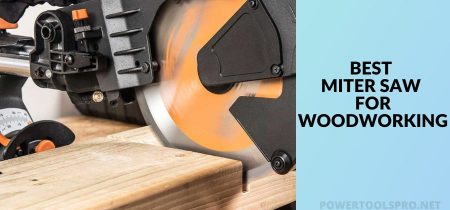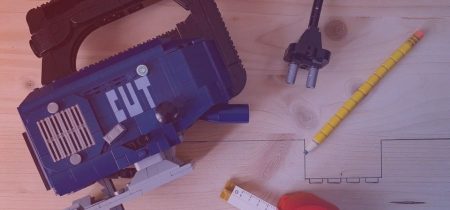Cutting plywood with a jigsaw can be difficult, especially if you’re not experienced using this type of saw.
Sawing through plywood can be incredibly frustrating and challenging if you don’t know what you’re doing. You will end up with a rough, uneven, or jagged cut, making the job much harder.
Follow our simple guide on how to cut plywood with a jigsaw, and you’ll be able to make precise, clean cuts in no time.
What problems could you face while Cutting Plywood?
Many things can go wrong when you’re cutting plywood. You might end up with pieces that are too small or ones that are so large. You might also end up with rough edges or uneven cuts. In this blog post, we’ll discuss some of the most common problems you can face when cutting plywood and how to fix them. Stay safe.
Picked The Wrong Saw
A jigsaw is an efficient and versatile tool, but it is not ideal for cutting straight lines. If you want to cut straight lines, we recommend using a circular or table saw.
However, if you don’t have a barrel grip jigsaw, circular saw, or table saw, you can use a jigsaw. However, ensure that you use a guide with the tool to get straight cuts.
Splinters and Tear-Out
Plywood is susceptible to chipping and splintering. To avoid this, use a fine-tooth blade with the tool. Besides, these blades are the best for plywood and give clean cuts without shredding the wood.
Don’t Cut Large Pieces
Don’t try to cut large wood pieces in one go, especially when dealing with plywood. This can twist your clade, and you might see harmful flying splinters.
Account For The Kerf
When cutting plywood with a jigsaw, people’s most common mistake is not considering the kerf. If you don’t know what the kerf is? Let me elaborate. In simple words, the kerf is the material’s width you want to remove with your blade. Kerf is dependent on the blade’s width and the torn-off wood.
Jigsaw Can Jump
Not many know that it only cuts from the top when using a jigsaw for plywood. So, you cannot see its bottom while cutting. So, ensure your blade doesn’t bash into something, especially when moving up and down. Otherwise, your saw might jump.
Cutting Too Fast
Unlike Jigsaw for coping or a miter saw, you cannot push a jigsaw too fast when cutting plywood with a jigsaw. Similarly, people also tend to push too hard on the motor’s blade, which can break the blade and might cause damage to the tool’s motor.
Using Dull Blades
Dull blades are not good whether you are dealing with plywood or any other material. Hence it is advised to change the dull blades as soon as possible. This is because the dull blade produces less accurate cuts and can cause the wood to splinter. Furthermore, dull blades might also result in the risk of kickback.
How to cut Plywood with a Jigsaw without Splintering
Cutting plywood can be a tricky business. If you are not careful, you can end up with a big mess of splintered wood. But with a little patience and know-how, you can cut plywood cleanly and easily with a jigsaw.
But before we proceed further, let’s look at what causes splintering and how it can ruin your job.
What Causes Splintering?
Initially, cutting plywood with a jigsaw perfectly without splintering seems impossible, but all things considered, it is not that difficult. To cut plywood like a pro, you must understand the material’s basics.
Plywood features glued and stacked layers over an extremely thin sheet of wooden surface. Due to this stacking, plywood is extremely durable as a whole unit; however, individual sheets are not that durable; they are a fragile element.
Remember, you can cut these fragile sheets with a jigsaw or any other type of saw. However, you need to be vigilant as these thin wooden sheets cannot bear the force of a jigsaw.
If that happens, the top veneer or bottom-most veneer fibers bear all the force, and as they cannot bear the sheer force of a jigsaw, you will see tear-down or splintered wood pieces. In some cases, this can also break your cut-line.
Generally, splintering can happen when cutting plywood, but you need to prevent it to save your time and wallet. Some recommended measures you should take include:
- Ensure there is enough support for the fibers on the surface of your plywood;
- Limit the force that is affecting the fibers.
- Always remain proactive and use different cutting methods to get the desired results.
How to Cut Plywood with a Jigsaw perfectly
This section will teach you how to cut plywood with a jigsaw. We will also reveal some handy tips for making the process easier. So, keep reading for all the necessary information, whether you’re a contractor or just someone who needs to do some DIY work around the house.
Use the Correct Blade
Anyone who’s ever tried to cut plywood with the wrong type of blade knows that it can be a real pain. The splinters caused by a dull or inappropriate blade can be sharp enough to give you a good paper cut; we all know how those can sting.
So before tackling that plywood project, ensure you have the right blade for the job. A sharp, specialized plywood-cutting blade will help you avoid a trip to the first aid kit and give you a clean, splinter-free surface to work with. Trust us; your fingers will thank you.
In this case, we recommend you to go with a reverse tooth blade if you want the perfect and splintering-free results. A reverse tooth blade causes less tear out and splintering, and it is the best blade for plywood.
Another essential thing to pay attention to is the tooth count. A sharp blade with over 20 teeth per inch will work flawlessly for plywood.
Use a splinter guard
A jigsaw is a handy tool around the house, especially if you’re creative. But one thing that all jigsaw users know is that they can be pretty messy. Wood chips and sawdust go everywhere, and if you’re not careful, you can end up with a nasty splinter or two.
That’s why attaching a splinter guard to your jigsaw is recommended before you start cutting plywood. These guards are affordable and widely available and can save you a lot of grief down the road. So next time you reach for your jigsaw, ensure you’ve got a splinter guard attached first.
Score the cut beforehand
As any carpenter knows, there are few things more annoying than a splinter. Fortunately, you can avoid those problems with this hack. Before using a jigsaw to cut any plywood, score its surface with a sharp utility knife.
If you use a blade with downward-facing teeth, score the underside of the wood. And if the blade has upward-facing teeth, score the top side of the wood. This simple step will help to prevent those irritating splinters from ruining your day.
The sharpness of Blades Matter
There are several vital things to consider when choosing a saw blade, but the two most important factors are the type of blade and the number of teeth per inch.
Many people make the mistake of assuming that a dull or worn-down blade will work just as well as a new one, but that couldn’t be further from the truth. A dull blade will cause the wood to splinter and tear, making your project look sloppy and amateurish.
On the other hand, a saw blade with too many teeth will produce a smoother cut, but it will also take longer to make each cut. The best way to find the perfect balance is to experiment with different blades until you find one that suits your needs.
Apply tape to your intended cut-line
Anyone who has ever cut plywood knows that it can be a bit of a challenge. The wood tends to splinter and break easily, creating a messy and frustrating experience. Fortunately, there is a simple way to add extra support to the wood fibers along the cut-line and limit the force being applied to each fiber: taping the plywood before cutting.
The tape will handle the brunt of the saw’s force, making for a cleaner and smoother cut. Plus, it will save you from cleaning up a pile of wood shavings afterward. So next time you need to cut plywood, reach for the tape first. It just might make your life a little easier.
Try the double-cut approach
The double-cut approach is great for getting clean, precise cuts when using a jigsaw. First, make a shallow cut with the blade set to only cut about ¼ to ⅓ of the way into the sheet. Then, cut a second time with the blade set to cut the full thickness of the plywood sheet.
This technique is similar to pre-scoring and is especially useful when cutting large sheets of plywood. Not only will you get cleaner cuts, but you’ll also save yourself some time and effort.
Keep the Cutting Speed Moderate
No one likes a jigsaw puzzle that’s missing a piece. The same can be said of trying to cut plywood with a jigsaw- if you don’t do it right, you’ll end up with a mess. One of the common mistakes that people make when attempting to cut plywood is assuming that maximum speed produces the best results.
It’s a fair assumption as most jigsaws provide the best results when used at high speeds.
When cutting plywood, you want to aim for moderate speed instead of blazing fast cuts. This will help to prevent the wood from splintering and produce a cleaner overall cut.
For this purpose, I recommend you use a jigsaw with a variable speed dial or speed controlling lever as it will be more efficient than the others. So next time you reach for the jigsaw, remember: slow and steady wins the race.
Tips and Tricks To Get Clean Cuts on Plywood
Try masking tape: To avoid problems cutting the plywood, put masking tape on the front and back of the wood where you want the cut. The masking tape will hold the plywood together and prevent the blade from catching.
Besides, it will also help prevent the veneer’s outer layer from tearing or breaking. So next time you need to cut plywood, be sure to reach for the masking tape. It will save you a lot of time and frustration.
Ensure Saw’s speed: The plywood is thin and delicate, and you need to be careful not to damage it. One of the best ways to get clean, precise cuts is to ensure that the blades on your saw are moving at maximum speed.
This way, you can push the plywood through the saw without worrying about the blade catching and tearing the wood. So when cutting plywood, give your blades a little boost first.
Use it with steady speed: If you’ve ever watched someone operate a hand saw, you know there’s an art to it. While it may seem simple, sawing takes precision and practice. The key is to apply consistent pressure and speed as you move the saw back and forth. You’ll have a jagged edge if you rush through the cut or apply too much pressure.
On the other hand, if you go too slowly or use too little pressure, the cut will be less precise.
To avoid this issue, find a middle ground and go at a steady pace. With a little practice, you’ll be sawing like a pro.
Apply a Pilot Cut Using Utility Cutter: Tearing is one of the worst things to happen when trying to make a precise cut in plywood. No matter how careful you are, the blade always manages to catch on the wood and create a jagged, uneven edge.
The key is to use a utility cutter to score the surface of the plywood before you start cutting. This will create a shallow groove that guides the blade, ensuring that it stays on track and produces a clean, tear-free cut.
So next time you want a clean and precise cut in plywood, remember this simple tip and avoid the frustration of tearing.
Jigsaw Safety Tips
Looking to cut some lumber like a pro? Jigsaws are a great tool for the job, but they can be dangerous if used improperly. Here are some useful safety tips while using your jigsaw:
Protection From Shocks: Remember, jigsaws are not the ideal choice for wet environments. Results can be deadly if you use or expose it to water or moisture. Hence always use a jigsaw in a dry and covered place.
Protection From Fire: Most jigsaws are designed to be used with an RCB circuit breaker, which automatically shuts off power during a power surge. However, if you accidentally or intentionally use a jigsaw with a non-RCB circuit, the excessive power flow can cause a fire or even shock the operator.
Beware of the Lacerations: Another common injury associated with a jigsaw is lacerations. This usually happens when the operator places their hand too close to the reciprocating blade, causing it to slice into their skin.
Workers should only operate a jigsaw if it has a sharp blade to reduce the risk of lacerations. In addition, ensure you are wearing protective gloves and long sleeves to protect your skin.
Other Jigsaw safety tips are:
- Read the product’s manual before using the tool. If you don’t have a manual get a copy or visit the manufacturer’s website.
- Wear the appropriate and recommended protective gear and equipment when using a jigsaw. This includes protective glasses, steel-toe work boots, and a dust mask.
- Never force the jigsaw through the stubborn material. If you cannot cut it, reverse it and try cutting it again.
- Keep the blade and other components well-lubricated.
- Be careful, and don’t trip over wires connected to your jigsaw.
In the End:
So there you have it, our complete guide on how to cut plywood with a jigsaw perfectly. We hope this comprehensive post helps you to understand the basics of using this saw and enables you to start cutting like a pro. Always use safety gear when operating any power tools and take care when handling sharp blades – happy sawing!




